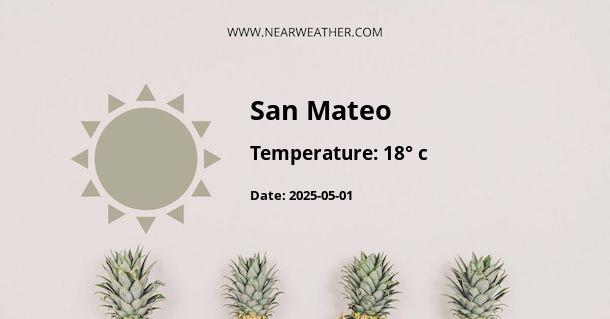San Mateo, California: Climate and Weather Overview
Situated in the heart of the San Francisco Peninsula, San Mateo, California experiences a Mediterranean climate characterized by mild, wet winters and dry summers. The city's unique location near the Pacific Ocean and San Francisco Bay significantly influences its weather patterns, making it an ideal destination for those who enjoy temperate climates and outdoor activities year-round.
Annual Climate Data for San Mateo, CA
The climate in San Mateo can be best explained by examining its annual weather data. The table below provides a comprehensive overview of the city's average temperatures and precipitation levels throughout the year:
| Month | Average High (°F) | Average Low (°F) | Precipitation (in) |
|---|---|---|---|
| January | 58 | 44 | 4.01 |
| February | 61 | 46 | 3.14 |
| March | 63 | 47 | 2.79 |
| April | 66 | 48 | 1.11 |
| May | 68 | 50 | 0.43 |
| June | 71 | 53 | 0.14 |
| July | 73 | 55 | 0.01 |
| August | 74 | 56 | 0.03 |
| September | 74 | 55 | 0.12 |
| October | 71 | 53 | 0.81 |
| November | 64 | 48 | 2.05 |
| December | 58 | 44 | 3.2 |
Source: National Oceanic and Atmospheric Administration (NOAA)
As indicated in the table, the summer months in San Mateo are characterized by warm, dry weather with average high temperatures ranging from 71°F to 74°F. In contrast, the winter months experience cooler temperatures with average highs ranging from 58°F to 66°F, accompanied by moderate precipitation.
Microclimates in San Mateo, CA
San Mateo's proximity to the coast and its diverse topography contribute to the presence of microclimates within the city. The western portions of San Mateo, closer to the ocean, tend to experience cooler temperatures and higher humidity levels, while the eastern areas, further inland, may have slightly warmer and drier conditions.
Furthermore, the influence of the nearby San Francisco Bay can lead to localized weather variations, with areas near the bay experiencing milder temperatures compared to those located further inland. It is important for visitors and residents to be aware of these microclimatic differences when planning outdoor activities or travel within the city.
Weather Hazards and Concerns
While San Mateo generally enjoys mild and pleasant weather, there are certain weather hazards and concerns that residents should be prepared for. The region is susceptible to occasional fog, especially during the summer months, which can impact visibility on roads and highways. Additionally, the proximity to the Pacific Ocean exposes the area to the risk of coastal fog and low clouds, particularly in the early morning and late evening hours.
Moreover, the city may experience winter storms, which can bring heavy rainfall and increased potential for flooding in low-lying areas. It is essential for residents to stay informed about weather forecasts and any potential advisories issued by local authorities during periods of inclement weather.
Conclusion
In conclusion, San Mateo, California offers a Mediterranean climate with mild, wet winters and dry summers. Its unique location, microclimates, and proximity to the Pacific Ocean and San Francisco Bay contribute to the city's diverse weather patterns. By understanding the climate and weather characteristics of San Mateo, residents and visitors can better prepare for outdoor activities and stay informed about potential weather hazards throughout the year.
A - San Mateo's Latitude is 6.401110 & Longitude is -72.555634.
A - Weather in San Mateo is 14° today.
A - Climate Conditions in San Mateo shows overcast clouds today.
A - Humidity in San Mateo is 89% today.
A - Wind speed in San Mateo is 7.27 km/h, flowing at 113° wind direction. today.
